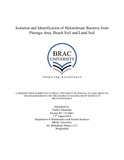Isolation and identification of halotolerant bacteria from patenga area, beach soil and land soil

View/
Date
2016-08-17Publisher
BRAC UniversityAuthor
Tabassum, NafisaMetadata
Show full item recordAbstract
Salinity provides an unhealthy environment that restricts normal crop production in Bangladesh. The saline soil lack Nitrogen and Phosphorous and become nutrient deficient and the organic matter content of the soils is also reduced. Micronutrients, such as Cu and Zn are widespread. Therefore the possibilities of increasing potential of these saline lands for increased production of crops is by the isolation of halotolerant bacteria that contains the salt tolerant gene which when transferred into the plants uptake salt as nutrient and store in them for higher yield. The study focused on the isolation and identification of the halotolerant bacteria. Three samples were taken from the Patenga area, beach soil and land soil near the coastal area of Chittagong. The samples were inoculated in nutrient media containing wide range of salt concentrations. All the samples showed that they are 2% (w/v), 4% (w/v) and 6 %( w/v) salt tolerant. Total 18 isolates were subcultured and 9 of them were further tested. The soil sample collected from Patenga with 4%(w/v), 6%(w/v) salt tolerance and the isolate from beach soil with 2% (w/v)salt tolerance showed catalase activity and all the isolates showed negative result for oxidase activity, indole production, phenol red lactose and motility. In addition to these, all the samples provided positive result for phenol red dextrose. Other biochemical test provided mixed result for the samples. Based on the morphological characteristics, biochemical test and ABIS software analysis the isolates fall within the Enterobacteriaceae, Clostridium and Corynebacterium, with a predominance of Pastuerellaceae and Vibrios. Overall the isolates were widely halotolerant, with best growth observed at lower salinities and no halophilism. The bacterial strains Volucribacterpsittacicida, Pantoeastewartii subsp.stewartii, Clostridiuminnocuum, Brevibacillusagri, Aggregatibacter (Haemophilus) segnis, Corynebacteriumxerosis, Vibrio metschnikovii were predicted to be present in the sample. The gene responsible for the salt tolerant trait in these bacteria can be identified, extracted and finally inserted into the crop plants to form a transgenic plant. These transgenic plants will now be enriched with this new trait the ability to resist wide range of salt concentrations. The plants will uptake the salt as nutrient and will store them to grow and enrich for high crop production for the rest of the year.
